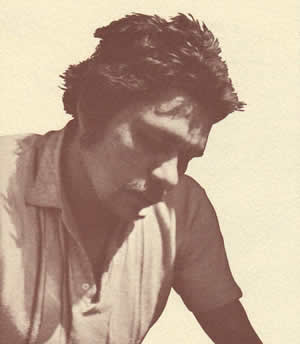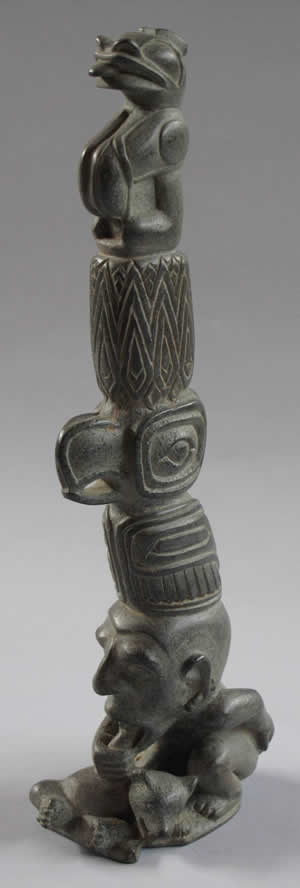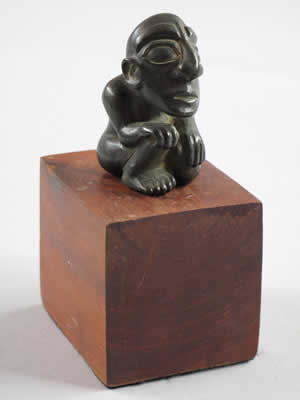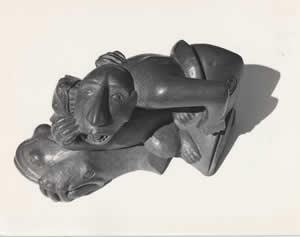People: John Julius Wilnoty (b. 1940)
John Julius Wilnoty (1940-2016) is an acclaimed Cherokee sculptor and a somewhat enigmatic figure among Cherokee artisans. Known for carvings that display a rich and complex mythology, Wilnoty was completely self taught. He works primarily in steatite, a dark-hued pipestone. His work has been included in many articles and exhibitions, including the Smithsonian Institution. In 1971 his work was shown at Qualla Arts and Crafts Mutual, where he displayed 21 carvings on loan from a variety of collections, including the Indian Arts and Crafts Board, Qualla Arts and Crafts Mutual, Burgess Indian Museum, and the Medicine Man Craft Shop. His sons, Fred Wilnoty and the late John Wilnoty, Jr. also established themselves as carvers.
John Julius Wilnoty has been described as a “legendary” figure among Cherokee artisans. A member of the Eastern Band, Wilnoty was born in the Bigwitch community and later lived in Wolftown. He grew up with little formal education. As a carver, he is completely self-taught, taking up carving when he was about twenty years old in the early 1960s. Struggling to find a way to make a living at that time, he “picked up some little pieces of pipe rock and carved faces on them.” He took these first efforts to a friend and those first pendants quickly sold. Likely that friend was Tom Underwood, long-time owner of Medicine Man Crafts, one of a handful of Cherokee outlets that sells authentic work. In a 1970s interview, Underwood recalled that Wilnoty had “a magic touch with what he does in wood and stone.” Wilnoty’s successful efforts led him to consider making other forms in stone. He discovered inspiration from a collection of pipes at the Museum of the Cherokee Indian. Underwood recalled that soon Wilnoty brought in “one or two pipes and they were beautifully done, the very first ones he had ever made.” Recognizing his own innate talent, Wilnoty turned to carving in earnest, educating himself by studying images in books and further examining artifacts in the museum’s collection. Wilnoty’s pipes are carved from steatite, a dark-hued pipestone also known as soapstone. While he has made plain pipes, more often his work displays complex figures as part of the composition.
Wilnoty’s carvings are often complex, with multiple figures entwined together. Rodney L. Leftwich, author of Arts and Crafts of the Cherokee (1970), noted that Wilnoty derived “great pleasure in ‘hiding’ smaller designs of birds and other animals within the figures of larger ones.” He went on to describe collectors who, “months later, upon closer inspection, find all kinds of tiny figures clearly visible within the feature of the work.” By 1971, Wilnoty was a member of Qualla Arts and Crafts cooperative. In conjunction with the Indian Arts and Crafts Board, the co-op honored Wilnoty with a solo exhibition less than a decade after he began learning his craft. The exhibition included twenty-one carvings on loan from a variety of collections, including the Indian Arts and Crafts Board, Qualla Arts and Crafts Mutual, Burgess Indian Museum, and the Medicine Man Craft Shop. The four-page brochure described Wilnoty’s “impressive carving skills in stone, wood, and bone, in combination with his highly imaginative and expressive handling of sculptural forms.”
As an artist, Wilnoty has been described by writers as “elusive” and “electric.” He seems driven to produce; his “artistic temperament” is legendary. Working at odd hours of the day and night, Wilnoty has been described as a “tinkerer, a mechanic, a gunsmith, and a remaker of old tools.” It is this breadth of tactile experience that has contributed to the intricacy of his skill. Tom Underwood described his work as covering the “whole spectrum of stone sculpture….He follows the most acute sense of line proportion and design of any living sculptor today,” he opined. Wilnoty has “an eighth sense that tells him when a thing is right,” Underwood concluded. That rightness shows up in work that includes multiple figures that can be looked at from various points of view. Sometimes it is difficult to tell whether or not a piece has a front or a back; it is truly a work in the round. Many of Wilnoty’s pieces can be viewed from multiple angles, revealing their complex narrative stories. An often cited work was his Eagle Dancer, a twenty-nine inch sculpture, carved from a single piece of cherry. He used the grain of the wood as a guide for his carving, removing surplus material to reveal the graceful dancer. The dancer’s muscular body and eyes were enhanced by the grain of the wood. Of this piece, Wilnoty noted modestly, “Some people can’t see what can be done with a piece of wood.”
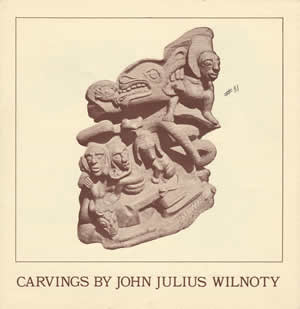
Carvings by John Julius Wilnoty cover
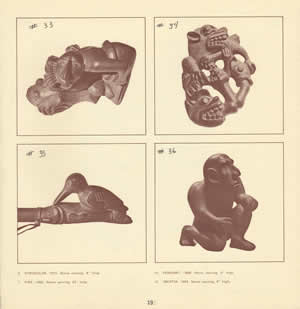
Carvings by John Julius Wilnoty page 3
In 1971, Wilnoty's work was shown on his home turf at Qualla Arts and Crafts Mutual; the following year he had a show at what was then known as the Pasadena Art Museum, today's Norton Simon Museum in California. The exhibition included twenty-five pieces carved in red and grey steatite (pipestone), all part of a San Jose private collection. Wilnoty's work was also show at the Smithsonian Institution and the Washington, DC-based Indian Arts and Crafts Board collected many works. His sons, Fred Wilnoty and the late John Wilnoty, Jr., also established themselves as carvers.
Anna Fariello
Excerpted from Cherokee Carving: From the Hands of our Elders, 2013
Works Cited
Bockhoff, Esther. “Cherokee Carvers: The New Tradition,” The Explorer 19.3 (1977): 4-11.
Indian Arts and Crafts Board. Carvings by John Julius Wilnoty (Cherokee, NC, 1971)
Laurence French and Jim Hornbuckle (eds). The Cherokee Perspective: Written by Eastern Cherokees (Boone, NC: Appalachian Consortium Press, 1981).
Leftwich, Rodney L. Arts and Crafts of the Cherokee (Cherokee, NC: Cherokee Publications, 1970).
Norton Simon Museum Archives, Pasadena, CA.
Qualla Arts and Crafts Mutual. Cherokee Artists 2: The Woodcarvers. Film (Cherokee, NC, 1994).

